A Visit to Panama
Posted on February 2, 2014 by bob in Travel
 by Andrea Gross; photos by Irv Green
by Andrea Gross; photos by Irv Green
I’m standing on the deck of a 24-passenger catamaran, watching the sun rise over the Pacific. Yes, that’s right. The sun is rising over the Pacific. Here, in the Central American country of Panama, positioned between two continents and two oceans, I can see a bit of the Pacific that juts to the east, poking into a portion of the Atlantic. So when the sun rises in the east, it appears over Pacific waters.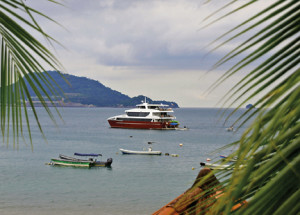
I find this intriguing but at the same time unsettling. But then, many things in Panama force me to rearrange my mind.
The hot pink hibiscus, the bright beaked toucans, the swirling skirts of the dancers… Everywhere I look the country pulsates with the psychedelic colors that inspired Paul Gauguin, and I’m on sensory overload for the first part of my trip. Then, bingo, I board the MS Discovery for my cruise through the Panama Canal. The bright colors disappear as I enter a more ordered world, one that’s muted, mechanical and often confined by the gray cement bricks of the locks. The right side of my brain wars with the left.
My husband and I are in Panama with Grand Circle Travel precisely because their tour offers country culture as well as Canal cruising. After all, there’s no doubt that the famed waterway has made the country a place to be reckoned with.
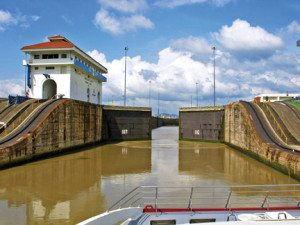 One hundred years ago this year, on August 15, 1914, the SS Ancon made the first official Canal passage between the Atlantic and Pacific. By eliminating the long trip around Cape Horn, the ocean-to-ocean journey was shortened by more than 8,000 miles. This feat transformed both global commerce and the country of Panama.
One hundred years ago this year, on August 15, 1914, the SS Ancon made the first official Canal passage between the Atlantic and Pacific. By eliminating the long trip around Cape Horn, the ocean-to-ocean journey was shortened by more than 8,000 miles. This feat transformed both global commerce and the country of Panama.
In 2015, after a $5.2 billion expansion is completed, the Canal will be able to handle larger ships, thus further fueling the country’s economy and increasing its importance.
We begin our tour in the capital of Panama, Panama City, which has morphed from a 15th century settlement (evident in the ruins of Panama La Viejo) to a 17th century Spanish colonial town (quickly becoming the go-to neighborhood for after-hours fun) to a 21st century metropolis that is both an international business center and a popular tourist destination. The city’s history is fascinating, the atmosphere electric, but still, I’m glad when we head out to the rural areas.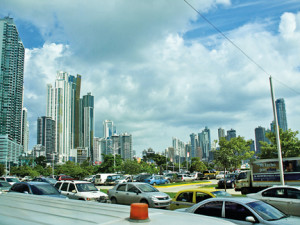
We stop at an agricultural cooperative where farmers work together to bring their produce to market, a sugar cane farm where a husband and wife have a small candy-making business, a school where youngsters perform traditional dances and their mothers serve us a homemade lunch, and a private home where the owner teaches us to make one of his grandmother’s favorite dishes. At each place our hosts talk freely, giving us insight into their daily lives. I emerge from these visits well fed and well informed.
 We learn about yet another Panamanian lifestyle when we meet the Embera people, members of one of Panama’s seven indigenous tribes. I step out of our dugout canoe to find a village of thatched huts perched on stilts, an open-air schoolhouse, a soccer field, a meeting hall, a woman weaving baskets and an entire community of people in traditional attire.
We learn about yet another Panamanian lifestyle when we meet the Embera people, members of one of Panama’s seven indigenous tribes. I step out of our dugout canoe to find a village of thatched huts perched on stilts, an open-air schoolhouse, a soccer field, a meeting hall, a woman weaving baskets and an entire community of people in traditional attire.
The tribal spokesman explains that opening their village to outsiders allows the Emberas to earn a living while continuing to live according to the ways of their ancestors. It’s a Margaret Mead experience, and I love every minute. 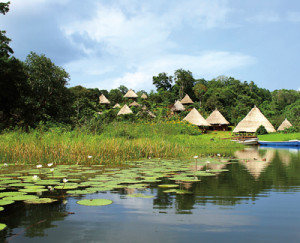
In between people visits, we take mini treks through the rainforest. Unlike the men who built the Canal, we’re slathered with sunscreen, protected with insect repellent, and our only goals are to see a monkey, spot a toucan and track a capybara. We aren’t charged with digging a path through a thick jungle where the temperature is often above 80º and the humidity above 90%. Of the 80,000 men who worked on the Canal, more than a third died of yellow fever or malaria.
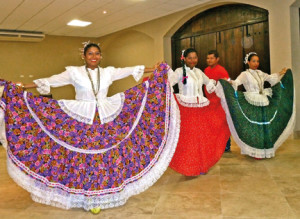 A normal trip through the Canal takes ten hours, but our tour has arranged for a full daylight passage. We enter on the Pacific, head northwest through two sets of locks that raise the Discovery 85 feet above sea level, cross the Continental Divide and spend the night on Gatun Lake. The next morning we go ashore to visit the Gatun Dam and take our final rainforest trek, which reminds us of the travails that went into building the Canal. Then we re-board our ship, go through the final set of locks and descend to sea level in another ocean.
A normal trip through the Canal takes ten hours, but our tour has arranged for a full daylight passage. We enter on the Pacific, head northwest through two sets of locks that raise the Discovery 85 feet above sea level, cross the Continental Divide and spend the night on Gatun Lake. The next morning we go ashore to visit the Gatun Dam and take our final rainforest trek, which reminds us of the travails that went into building the Canal. Then we re-board our ship, go through the final set of locks and descend to sea level in another ocean.
I go to the upper deck and look to the west. Yes, the sun is setting over the Atlantic.
You can find more resources online at www.gct.com/pma.









